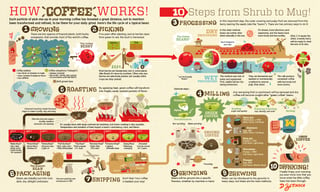Every single morning coffee or mid-afternoon pick-me-up you’ve consumed has been on an incredible journey, with many coffee ingredients coming from the other side of the world and undergoing countless refining processes before they reach your coffee cup. Here’s a little more about the life cycle of a typical coffee bean.
 Image above has been created by Dan Zettwoch www.danzettwoch.com
Image above has been created by Dan Zettwoch www.danzettwoch.com
The Growing Stage
There are two types of evergreen plants that produce most of the world’s coffee. First off, there’s the Arabica bean. Largely grown in Latin America but with plantations also in Africa and Papua New Guinea, this plant produces beans that have a softer, sweeter taste. Arabica plants require very exact conditions to grow – they must be grown at a certain altitude, and they’re quite vulnerable to disease and pesticides.
The other type of plant is the Robusta. Grown exclusively in the eastern hemisphere in regions of Africa and Indonesia, Robusta (as the name might suggest) is a little more robust.
Picking and Processing
Once the berries on these plants ripen from green to red, they’re picked by hand or machine. Then the beans must be processed. There are two types of processing:
- Dry Processing – this longer, more laborious method involves leaving the beans (technically berries) out in the sun. After 2-4 weeks, the berry sheds its outer skin to become more like the coffee bean we know a love.
- Wet Processing – this method uses plenty of water and lots of expensive equipment, which makes it ideal for the mass producers of coffee throughout the world. Viable berries rise during immersion, then they’re fermented and wash to remove any pulp. Once they’ve dried, they produce a coffee with a little less body than those that have been dry processed.
Milling and Roasting
The beans need to be milled – which includes hulling, cleaning, sorting and grading the beans accordingly. Optional steps in this part of the process include polishing, ageing and decaffeinating.
From here, the coffee beans head off to be roasted, when they’ll turn from fresh, bright green to that rich brown colour we know so well. This is usually carried out with huge commercial machines – but home roasting is possible for the enthusiasts out there!
Depending on the temperature of the roast, the bean will emerge with a slightly different colour. Beans roasted at 475 degrees Fahrenheit are known as Italian roast and are usually used for espresso. As the temperatures decrease, the colour becomes lighter and creates a different kind of roast – French roast, Vienna roast, City roast, American roast, etc.
Packing and Shipping
From here, the roasted beans are packed and shipped to locations all over the world! Coffee is one of the world’s most popular and commonly imported drinks, so the scale of the packing and shipping process defies belief!
Grinding and Brewing
When the beans arrive at their destination, they’ll be ground – either using a machine or by hand. Then they’re brewed using one of many different methods and tools – including the vast array of coffee machines available. Fully automatic coffee machines combine the processes of grinding and brewing for total efficiency. The machinery also brews and grinds each and every batch in the exact same way, making it possible to have consistent coffees, every time. Milk can also be added at any stage during the process, as well as other tasty additions like chocolate to cater to any tastes or cravings.
The Drinking Stage
The stage we’ve all been waiting for! Now you know the journey each little coffee bean undertakes on its way to your morning coffee or afternoon treat. Hopefully now you can appreciate every delicious sip more than ever before! For special recipes have a look at the 'Passion for Coffee' section on our website.


